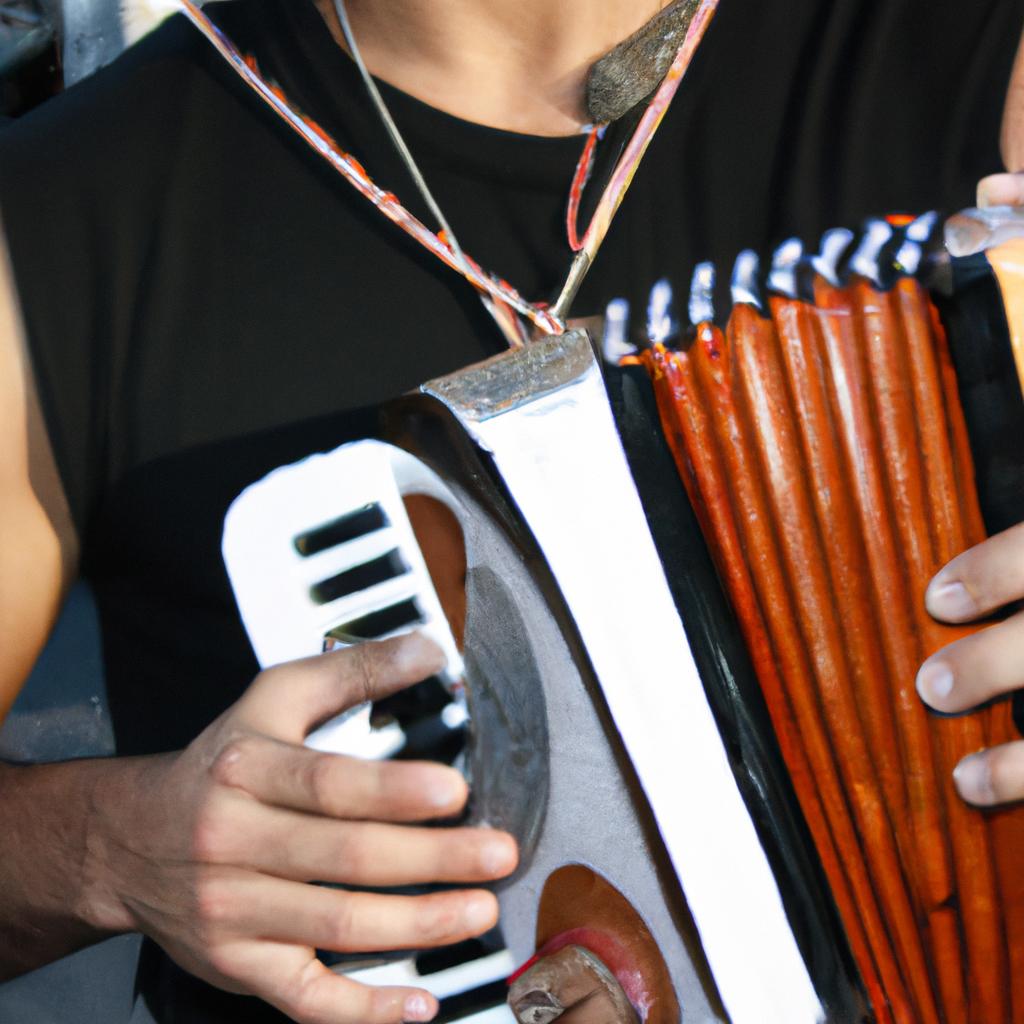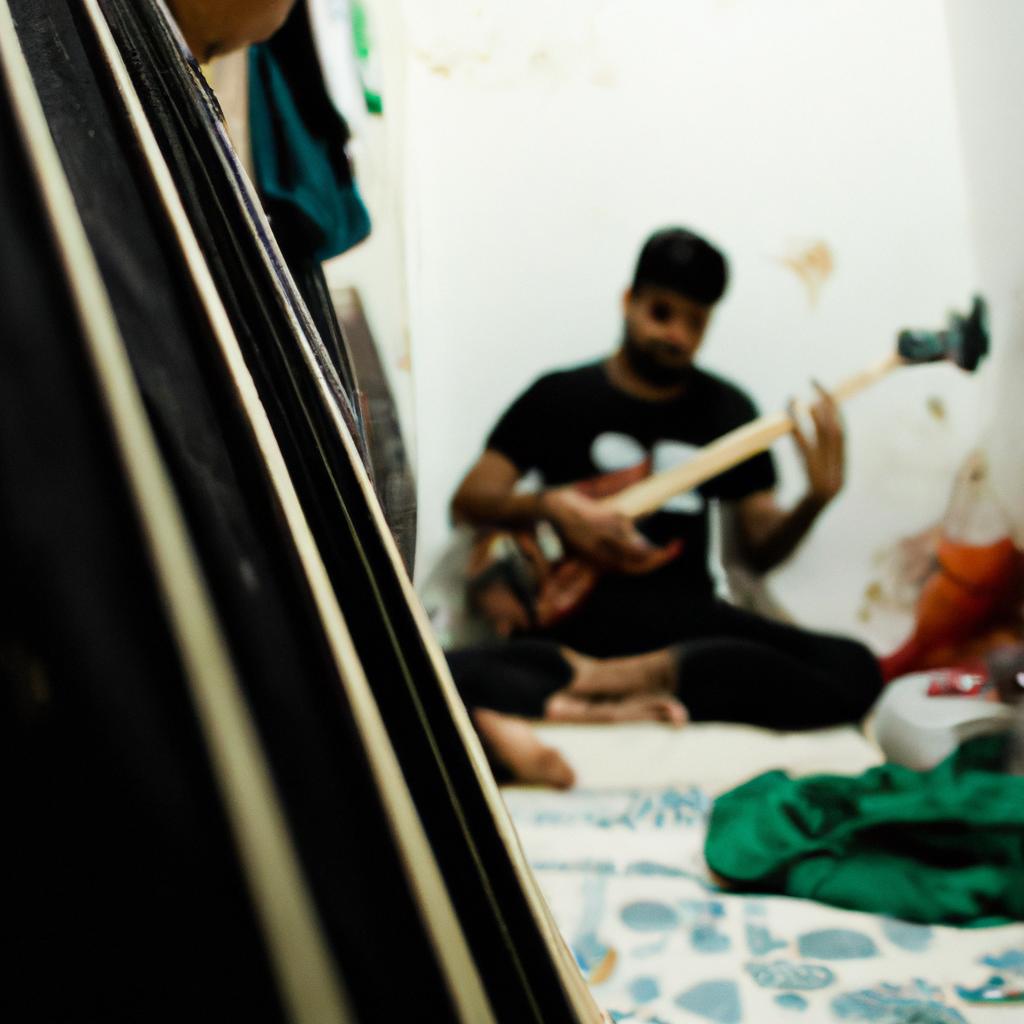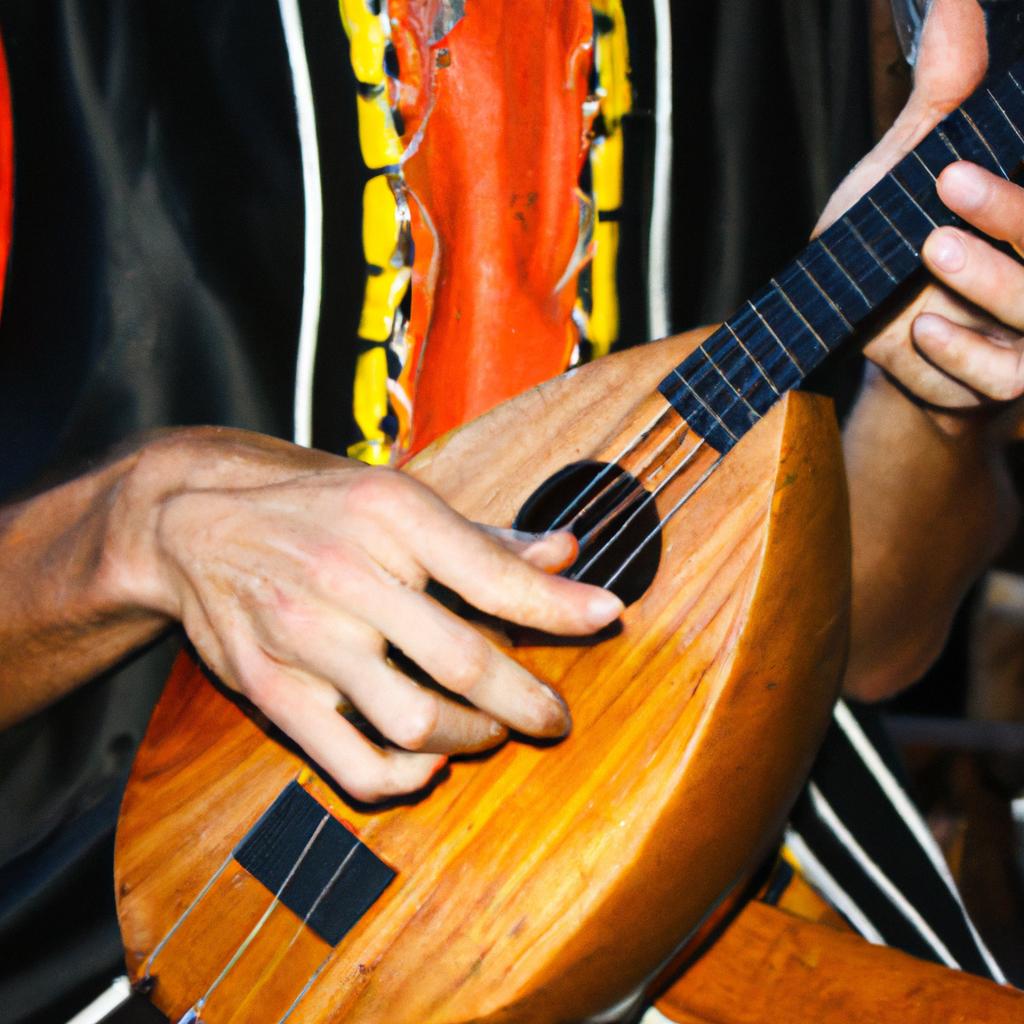The art of tango is characterized by its graceful movements and passionate expressions. Central to the beauty of this dance form is the intricate technique displayed by the musicians who accompany it. In particular, ornaments play a significant role in enhancing the musicality and adding an extra layer of artistry to tango instrument playing. For instance, imagine a bandoneon player delicately embellishing their melody with subtle trills and mordents, creating a mesmerizing atmosphere that captivates both dancers and spectators alike.
Ornaments are decorative elements added to melodic lines and chords in music, often consisting of small flourishes or variations in pitch, rhythm, or articulation. Within tango instrument technique, these ornamental gestures serve as expressive tools for musicians to convey emotions such as longing, desire, joy, or melancholy. The execution of ornaments requires precision and control while maintaining a sense of spontaneity and improvisation—a delicate balance achieved through years of practice and mastery.
Beyond mere embellishments, ornaments contribute greatly to the overall aesthetic appeal of tango music. They bring depth and complexity to melodies and harmonies, transforming them from simple notes on paper into soul-stirring compositions. This article aims to delve deeper into the world of ornaments in t tango music, exploring their various types and techniques, as well as their significance in the context of tango performance.
In tango music, there are several types of ornaments commonly used by musicians to add flair and emotion to their playing. These include trills, turns, mordents, appoggiaturas, glissandos, and slides. Each ornament has its unique characteristics and can be applied differently depending on the instrument being played.
Trills are rapid alternations between two adjacent notes, adding a shimmering effect to the melody. Turns involve a quick upward or downward movement from one note to another, creating a subtle embellishment. Mordents consist of a rapid alternation between the main note and a lower neighboring note before returning to the main note. Appoggiaturas are grace notes that occur just before the main note, emphasizing its importance and creating tension.
Glissandos and slides are sliding movements between notes or chords. Glissandos involve smoothly sliding from one pitch to another within a specified range, while slides typically refer to sliding up or down the fingerboard of string instruments or across keys on wind instruments.
The execution of these ornaments requires technical skill and musical sensitivity. Musicians must have precise control over their instrument to execute them accurately while maintaining a sense of spontaneity and improvisation that is characteristic of tango music.
Ornaments not only enhance individual melodies but also contribute to the overall harmonic texture of tango compositions. They can be used to highlight certain chord tones or create dissonant tensions that resolve into consonance. By incorporating ornaments into their playing, musicians can transform simple chord progressions into rich harmonies that evoke strong emotional responses from listeners.
In conclusion, ornaments play an integral role in the artistry and expressiveness of tango music. They add depth, complexity, and emotional intensity to melodies and harmonies while showcasing the technical prowess of musicians. Whether it’s the delicate trills of a bandoneon player or the expressive slides of a violinist, ornaments enrich tango performances and transport audiences into the passionate world of this captivating dance form.
The Role of Ornaments in Tango Instrument Performance
Imagine a tango performance where the bandoneón player skillfully weaves intricate ornaments into their melodies, adding nuanced embellishments that captivate the audience. These ornaments, also known as decorations or graces, are essential elements of tango instrument technique and play a significant role in shaping the music’s expressive quality. In this section, we will explore the importance of ornaments in tango instrument performance by examining their impact on rhythm, phrasing, emotion, and communication.
Ornaments serve to enhance the rhythmic intricacy within tango music. By inserting trills, turns, mordents, or appoggiaturas at specific points in a melody, musicians create subtle variations that highlight certain beats or syncopated rhythms. This deliberate manipulation of timing adds complexity and depth to the overall musical texture. For instance, consider a hypothetical scenario where an accordionist introduces a series of rapid trills during a particularly intense part of a milonga piece. The unexpected ornamentation not only accentuates the underlying rhythm but also amplifies the emotional intensity for both performers and listeners alike.
In addition to enhancing rhythm, ornaments contribute significantly to phrasing in tango instrument performance. Musicians employ various techniques such as slides (glissandi), grace notes (acciaccature), and vibrato to shape individual phrases within a larger musical context. These gestures articulate melodic contours while articulating important harmonic progressions or cadences. Through careful execution of these ornamental figures, performers can convey subtle nuances and inflections that communicate emotions like longing, nostalgia, or passion more effectively.
To further demonstrate the impact of ornaments in tango performances visually:
- Trills: Rapid alternations between two adjacent notes
- Turns: A sequence consisting of three notes: upper auxiliary note above principal tone – principal tone – lower auxiliary note below principal tone
- Mordents: A rapid alternation between the principal tone and a lower auxiliary note
- Appoggiaturas: Ornamental notes that approach a main melodic note by a small interval
Table: Examples of Ornaments in Tango Instrument Performance
| Ornament | Description | Example |
|---|---|---|
| Trills | Rapid alternations between two adjacent notes | E-F-E |
| Turns | Upper-lower-upper sequence around a principal tone | C-D-C-B-C |
| Mordents | Alternation between the principal tone and lower pitch | G-G#-G |
| Appoggiaturas | Small ornamental notes leading to a main melodic note | D-C#-D |
In conclusion, ornaments hold great significance in tango instrument performance. Through their influence on rhythm, phrasing, emotion, and communication, these decorations shape the expressive character of the music. The strategic incorporation of ornaments adds depth and complexity to melodies while allowing performers to convey an array of emotions more effectively. In the subsequent section, we will explore the historical significance of ornaments in tango music as we delve into its rich cultural heritage and evolution over time.
Exploring the Historical Significance of Ornaments in Tango Music
Transitioning from the exploration of the role of ornaments in tango instrument performance, we now delve into the historical significance of these embellishments within tango music. To illustrate this significance, let us consider a hypothetical example: imagine a renowned tango orchestra performing at a grand ballroom in Buenos Aires during the Golden Age of Tango. The bandoneón player, known for his mastery of ornamentation techniques, expertly inserts trills and mordents throughout his solo lines, captivating the audience with his virtuosic display.
Ornaments in tango instrumentation serve multiple purposes that enhance the overall musical experience. They add color and expressiveness to melodies, infusing them with emotion and intensity. By incorporating subtle variations through ornaments, musicians can convey different shades of feeling such as longing or joy. Furthermore, ornaments contribute to the rhythmic richness of tango music by accentuating certain beats or syncopating others. This rhythmic complexity adds an element of surprise and dynamism to performances, keeping listeners engaged and intrigued.
To better understand the impact of ornaments on tango music, let us explore some key characteristics associated with their usage:
- Ornamental flexibility: Tango musicians have historically enjoyed artistic freedom when it comes to choosing which ornaments to use and how to employ them within their compositions. This flexibility allows performers to showcase their individuality while still adhering to the stylistic conventions inherent in tango music.
- Emotional resonance: Ornaments possess an inherent ability to evoke powerful emotions within listeners. Whether it be through soaring melodic flourishes or delicate trills that tug at heartstrings, they form an integral part of capturing and conveying the essence of Argentine passion embedded deep within tango tradition.
- Cultural heritage preservation: As one looks back upon the evolution of tango music over time, ornaments emerge as vital components that help preserve its rich cultural heritage. Through careful study and practice of traditional ornamentation techniques handed down from generation to generation, musicians ensure the continuity and authenticity of tango’s expressive language.
In summary, ornaments in tango instrument technique hold a significant historical value that goes beyond mere decorative elements. They serve as vehicles for emotional expression, add rhythmic complexity, allow for individual artistic interpretation, and contribute to the preservation of cultural heritage. Understanding these aspects sets the stage for delving into the different types of ornaments used in tango instrumentation.
Understanding the Different Types of Ornaments Used in Tango Instrumentation
Building upon our understanding of the historical significance of ornaments in tango music, we now turn our attention to examining the different types of ornaments utilized in tango instrumentation. By delving deeper into these intricate embellishments, we can gain a comprehensive insight into the artistry and nuances that make tango music so captivating.
To illustrate this point, let’s consider a hypothetical scenario where an accomplished bandoneon player performs a soul-stirring rendition of Astor Piazzolla’s iconic composition “Libertango.” As their fingers glide effortlessly across the buttons, they tastefully incorporate various ornaments to enhance the expressive quality of their performance.
When exploring the diverse range of ornamental techniques employed in tango instrumentation, several key elements emerge:
-
Trills: Derived from baroque music, trills involve rapid alternations between two adjacent notes. In tango music, trills are often used to add intensity or create tension before resolving into melodic phrases. For example, a bandoneonist might execute a series of quick trills during a dramatic pause within a melody, evoking anticipation in listeners’ hearts.
-
Glissandi: These sliding movements on stringed instruments such as guitars or violins serve as vivid sonic portrayals of emotions like longing or desire. A passionate glissando performed on the violin can evoke bittersweet nostalgia while simultaneously conveying intense love and yearning.
-
Mordents: Characterized by brief decorative flourishes involving rapid alternations around a single note, mordents inject dynamic twists into melodies. When skillfully executed on piano keys or guitar strings, mordents infuse moments with playful energy and unexpected surprises that captivate audiences.
-
Acciaccaturas: Often referred to as “crushed notes,” acciaccaturas are swift grace notes played immediately before the main note. In tango music, they can be utilized to create rhythmic tension or highlight dramatic moments within a composition. For instance, an acciaccatura played on a bandoneon just before the climax of a piece intensifies the emotional impact and leaves listeners breathless.
To better illustrate these ornamental techniques, let us examine their characteristics in the following table:
| Ornamental Technique | Instrument Used | Effect on Audience |
|---|---|---|
| Trills | Bandoneon | Evokes anticipation and intensity |
| Glissandi | Violin | Conjures bittersweet nostalgia and intense passion |
| Mordents | Piano | Adds playful energy and surprising twists |
| Acciaccaturas | Guitar | Enhances rhythmic tension and creates dramatic impact |
As we conclude our exploration into the different types of ornaments used in tango instrumentation, it becomes evident that these embellishments serve as powerful tools for musicians to convey emotions with subtlety and finesse. In our next section, we will delve further into unraveling the secrets behind mastering the art of ornamentation in tango playing, discovering techniques that enable performers to infuse their renditions with authenticity and virtuosity. So without further ado, let us embark on this fascinating journey together.
Mastering the Art of Ornamentation in Tango Playing
Having explored the various types of ornaments commonly used in tango instrumentation, we now delve into the intricate process of mastering these embellishments. By understanding their purpose and executing them with precision, musicians can elevate their performances to new heights.
To illustrate the significance of ornamentation in tango instrument technique, let us consider a hypothetical scenario. Imagine an accomplished bandoneon player performing “La Cumparsita” with no ornaments; while technically proficient, something seems lacking. Now envision the same musician adding subtle trills and grace notes at strategic moments throughout the piece. Suddenly, every note resonates with emotion and intensity, captivating the audience’s attention.
Mastering tango ornamentation requires careful consideration and skillful execution. Here are some key aspects to keep in mind:
- Timing and dynamics: Orchestrating ornaments effectively relies on a solid grasp of timing within each phrase. Skillfully varying dynamics adds depth and richness to the overall musical expression.
- Personal interpretation: While adhering to traditional styles is important, incorporating one’s own artistic interpretation allows for individuality and self-expression.
- Seamless integration: Ensuring that ornaments seamlessly integrate into a performance requires practice and meticulous attention to detail.
- Emotional connection: Ultimately, successful ornamentation evokes emotional responses from both performers and listeners alike.
The following table serves as a visual representation of how different types of ornaments contribute to specific emotional effects:
| Ornament | Emotional Effect |
|---|---|
| Trill | Intensity |
| Glissando | Fluidity |
| Mordent | Playfulness |
| Appogiatura | Yearning |
Incorporating these emotional effects into tango instrument performance adds depth and complexity to the music, allowing performers to truly connect with their audience. By mastering ornamentation techniques, musicians can create a captivating musical experience that leaves a lasting impression.
Now, let us explore some valuable tips and techniques for effectively incorporating ornaments into tango instrument performances. This comprehensive guide will provide practical insights on enhancing your playing skills while embracing the artistry of ornamentation in tango music.
Tips and Techniques for Incorporating Ornaments into Tango Instrument Performance
As musicians explore the artistry of tango playing, mastering the intricacies of ornamentation becomes paramount. By incorporating ornaments into their performances, instrumentalists can elevate their playing to new heights of expression and emotion. To illustrate this point, let us consider a hypothetical case study involving Alejandro, an accomplished bandoneón player seeking to enhance his tango technique.
Alejandro’s journey begins with understanding the various types of ornaments commonly used in tango music. These include trills, mordents, turns, and appoggiaturas. Each ornament carries its own unique flavor and purpose within a musical phrase. For instance, a well-executed trill can add intensity and vibrancy to a melodic line, while skillfully executed appoggiaturas lend moments of tension and release.
Incorporating ornaments effectively requires precision and practice. Here are some key considerations for musicians looking to master the art of ornamentation in tango instrument technique:
- Develop finger dexterity: Ornamentation often involves quick movements and intricate finger patterns. Regular exercises focusing on agility can help musicians develop the necessary dexterity required for executing ornaments fluidly.
- Study traditional repertoire: Immersing oneself in the vast repertoire of traditional tango compositions allows musicians to internalize common ornamentations employed by maestros who shaped the genre. Analyzing recordings and transcriptions can provide valuable insights into stylistic nuances.
- Experiment with different approaches: While there are established conventions regarding ornaments in tango music, exploring variations and personal interpretations adds individuality to one’s performance. Musicians should feel encouraged to experiment responsibly within the boundaries of tradition.
- Seek guidance from experienced performers: Mentoring relationships with seasoned tango musicians can be invaluable when honing one’s approach to ornamentation. Learning from those who have mastered this expressive aspect will aid aspiring artists in developing their own distinct style.
Table: Examples of Ornament Types and Their Effects
| Ornament | Effect on Tango Music |
|---|---|
| Trills | Adds intensity and vibrancy |
| Mordents | Creates ornamental embellishment |
| Turns | Conveys a sense of fluidity |
| Appoggiaturas | Provides moments of tension |
By skillfully incorporating ornaments into their playing, instrumentalists like Alejandro can harness the power of ornamentation to enhance the expressive and emotional elements of tango music. In the subsequent section, we will delve deeper into how these nuances impact the overall aesthetic experience for both performers and audiences alike.
[Transition sentence] Now let us explore further: The Impact of Ornaments on the Expressive and Emotional Elements of Tango Music.
The Impact of Ornaments on the Expressive and Emotional Elements of Tango Music
Ornaments in Tango Instrument Technique: The Graceful Artistry
Tips and Techniques for Incorporating Ornaments into Tango Instrument Performance have shed light on the various ways musicians can enhance their expression through ornamentation. Now, let us explore the profound impact that ornaments have on the expressive and emotional elements of Tango music.
Imagine a passionate tango performance where an experienced bandoneon player skillfully incorporates ornaments into their playing. As they execute a rapid trill during a climactic moment, it adds a touch of excitement and tension to the music, intensifying its emotional impact. This example illustrates how ornaments serve as powerful tools to evoke emotions and captivate listeners.
To further understand the significance of ornaments in tango instrument technique, consider the following points:
- Ornaments accentuate specific notes or phrases, highlighting their importance and drawing attention to significant musical moments.
- They contribute to the overall rhythmic complexity of tango music, adding layers of intricacy that engage listeners’ ears and create a sense of anticipation.
- Ornamentation allows performers to inject their own artistic personality into their interpretations, making each rendition unique and personal.
- By strategically placing ornaments within compositions, musicians can manipulate dynamics and shape the narrative arc of a piece, enhancing its dramatic effect.
The emotional impact of ornaments in tango instrument technique can be visualized through this table:
| Emotion | Ornament Example | Effect |
|---|---|---|
| Passion | Trills | Heightens intensity and adds fiery energy |
| Longing | Glissandos | Elicits yearning and melancholic feelings |
| Joy | Accented grace notes | Conveys exuberance and liveliness |
| Tension | Tremolos | Builds suspense and creates an electrifying atmosphere |
Incorporating these techniques with finesse enables musicians to connect deeply with audiences on an emotional level, transporting them to the heart of tango’s rich and passionate world.
In summary, ornaments play a crucial role in tango instrument technique by enhancing the expressive and emotional elements of the music. Through their careful incorporation, musicians can evoke passion, longing, joy, and tension within listeners. Understanding these techniques allows performers to craft captivating renditions that resonate deeply with audiences, making Tango music an art form renowned for its grace and allure.




